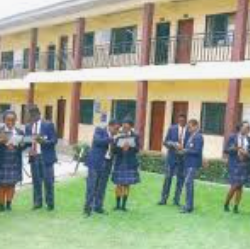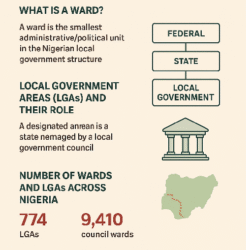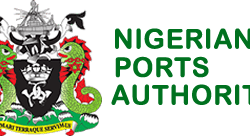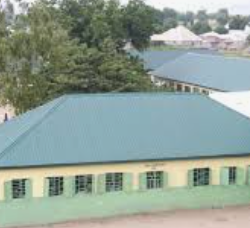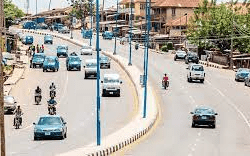Outline of course content for Electrical Electronic Engineering, Joseph Sarwuan Tarka University Makurdi (JOSTUM), Benue State, Nigeria.
100 LEVEL, FIRST SEMESTER
CHM 111 Basic Inorganic Chemistry (2-0-0).
Atoms. Molecules and chemical reactions, chemical equations and stoichiometry. Atomic structure and periodicity. Periodic Table and periodic properties.
Modern electronic theory of atoms. Valence forces. Structure of solids. Nuclear structure and radioactivity. Chemical bonding. Inter molecular forces. The chemistry of selected metals and non-metals.
CHM 151 Basic Experimental Chemistry I (3-0-0).
The theory and practice of volumetric and qualitative analyses. Redox titration.
CMP 111 Introduction to Computers (3-0-0).
Number systems and codes. Digital, analogue, and hybrid computers. Logic functions, gates and Boolean algebra. Computer circuits (adders, registers, subtractors, and flip-flops). Memory organisation. Symbols and notations.
Primitive, classical machine, and modern computer organisations. Introductory programming and micro processing methods.
GST 111 Communication in English I (2-0-0)
Introduction to use of English, vocabulary development, grammar (sentence, verbs and tenses, concord, phrases and clauses), phonetics, reading (definitions of reading, utilizing non-text information, text-attack skill, speed Reading etc.)
GST 113 Nigerian People, Culture and Contemporary Problems of Youths (2-0-0). Study of Nigerian History, Culture and arts in pre-colonial times. Nigerian’s perception of his world, Culture areas of Nigeria and their characteristics. Evolution of Nigeria as a political unit, indigene/settler phenomenon, concepts of trade, economic self-reliance, social justice, Individual development, norms and values, negative attitudes and conducts (cultism and other related vices), re-orientation of moral and national values, moral obligations of citizens, environmental problems.
A focus on the contemporary problems of youths such as Cultism, alcoholism/drug abuse, examination malpractices, student unrest (militancy), robbery, serious health problem (e.g. HIV/AIDS)
GST 115 History and Philosophy of Science (2-0-0)
Man- his origin and nature, Man and his cosmic environment, Scientific methodology, Science and technology in the society and service of man, renewable and non-renewable resources, man and his energy resources, Environmental effects of chemical plastic, Wastes and other materials, Chemical and radiochemical hazards, introduction to the various areas of science and technology.
MTH 111 Foundations of Mathematics (3-0-0)
Elementary set theory: union, intersection, complements, Venn diagrams. Real numbers: integer, rational, and irrational numbers. Real sequences and series, binomial theorem, mathematical induction. System of equations: matrices and determinants, solution of a system of linear equations; Gauss’s elimination method, Crammer’s method, matrix inversion method. Trigonometry: trigonometric identities and equations, circular measure, hyperbolic formulae, addition and factor formulae. Geometry: straight lines and circles, conic sections, translation and rotation of conic sections.
PHY 111 Mechanics, Properties of Matter and Head (3-0-0).
- Mechanics. Scalars and vectors; rectilinear motion – velocity and acceleration. Newton’s laws of motion, conservation of energy. Circular motion; simple harmonic motion. Gravitation; Kepler’s laws and Newton’s laws of gravitation. Rotational dynamics, moment of inertia, angular momentum, conservation laws. Hydrostatics – density, pressure, Archimedes principle, surface tension, adhesion, cohesion and capillarity. Hydrodynamics – continuity and Bernoulli’s equations and applications, viscosity, Poissenille’s equation; Reynolds number.
- Thermal Physics. Heat and temperature. The temperature scales. Heat capacity of solids, liquids, and gases. Calorimetry of an ideal gas. Modes of heat transfer: conduction, convection, and radiation. Energy spectrum of a black body. Inter-particle forces in solids, change of state. Thermal and electrical properties of metals.
PHY 191 Experimental Physics I (1-0-0).
Experiments arising from theory courses of PHY 111 and the illustration of basic physical techniques for observation, measurements, data collection, analysis and deduction.
STA 111 Basic Statistics (3-0-0).
Statistical data: their sources, collection and preliminary analysis by tables and graphs. Skewness and Kurtosis, measure of central tendencies. Mean, weighted mean, standard deviation, mode, median and variance (for grouped and ungrouped data). Analysis and presentation of data: curve fitting, goodness of fit (regression and correction), use of random numbers and statistical tables, sampling; small and large samples from finite and infinite populations.
Sampling distribution: normal, Poisson, hyper geometric, and binomial distributions. Estimation: expectations and moments of random variables, point and interval estimation of parameters, maximum likelihood estimation of parameters.

100 LEVEL, SECOND SEMESTER
MTH 112 Calculus (3-0-0).
Functions of a real variable: graphs, limits and idea of continuity, the derivative as the limit of rate of change. Techniques of differentiation. Extreme Curve sketching. Integration as an inverse of differentiation. Methods
of integration; definite integrals. Maximum and minimum points of the function. Applications to areas and volumes. Partial differentiation and applications.
PHY 132 Optics, Sound and Waves (2-0-0).
Reflection at plane and curved surfaces. Laws of reflection. Refraction at plane surfaces. Total internal reflection. Refraction through prisms; spectrometer. Lenses, defects of vision. Dispersion, spectra, chromatic aberration in optical instruments. Oscillation, forced oscillation. Resonance. Wave motion; transverse and longitudinal waves. Principles of superposition.
Diffraction, interference, velocity of light, dispersion. Polarization of light wave, sound waves, beats; Doppler effect. Waves in pipes, strings and rods.
PHY 142 Electricity and Magnetism (3-0-0).
Electrostatics: electric charges and method of charging. Coulomb’s laws. Resistances in series and parallel; e.m.f., Kirchhoff’s laws; potentiometer, Wheatstone bridge. Electrolysis, Faraday’s laws. Magnetic field and forces on a conductor, Hall effect. Magnetic fields of current-carrying conductors.
Electromagnetic induction, dynamo and generator, transformer. Magnetic properties of matter. A. C. currents
.
PHY 192 Experimental Physics II (0-0-3).
Experiments arising from theoretical courses of PHY 131 and PHY 141. The experiments will involve illustrations of basic physical techniques for observation measurements, data collection, analysis and deduction.
CHM 122 Basic Physical Chemistry (3-0-0)
Units and measurement in physical chemistry. State of matter and change of stste; Gases and their properties. Chemical equilibria; Thermochemistry; Introductory chemical kinetics; Acids, bases and salts; Redox reactions and redox potentials.
CHM 132 Basic Organic Chemistry I (3-0-0).
Historical survey of the development and importance of organic chemistry. Nomenclature and classes of organic compounds. Homologous series. Functional groups. Isolation and purification of organic compounds. Qualitative and quantitative organic chemistry. Stereochemistry. Determination of structure of organic compound. Electronic theory in organic chemistry. Saturated hydrocarbons. Unsaturated hydrocarbons. Alkyl halides. Benzene.
CHM 152 Basic Experimental Chemistry II (0-0-3).
Melting points and boiling points determinations. Heats of solution and neutralization; solubility and solubility curves, organic purification methods. Reactions and qualitative analysis of organic functional groups.
GST 112 Philosophy and Human Existence (2-0-0)
Philosophical foundations of human existence, a survey of the main branches of philosophy; nature of philosophical problems, philosophy and the evolution of human institutions: Science, Politics, religion, Morality, etc. Types, sources and foundations of knowledge, scientific and non-scientific knowledge, truth,
belief and opinion, appearance and reality; Basic notions in social and political philosophy, authority, power, equality, freedom, justices, etc
GST 116 Communication in English II (2-0-0)
Logical presentation of papers, phonetics, lexis, arts of public speaking and oral communication, figures of speech, report writing.
GST 114 USE OF LIBRARY, STUDY SKILLS AND INFORMATION COMMUNICATION TECHNOLOGY (ICT) (2-0-0)
Brief history of libraries, library and education, University libraries and other types of libraries, study skills (reference services), types of library materials, using library resources including e-learning, e-materials, etc.
Copyright and its implications, database resources, bibliographic citations and referencing.
200 Level
200 LEVEL, FIRST SEMESTER
CMP 211 Element of Programming (2-0-0).
Introduction to computer programming. BASIC language programming. Use of flow charts, algorithms, looping. Documentation of programming. Practical laboratory exercises in programming.
EME 201 Materials Science (2-0-0).
Engineering materials and types. Chemical nature of materials. Crystal structure and determination; crystal defects. Physical and mechanical properties; materials testing; deformation and fracture. Dielectric, electrical and electronic properties. Dielectric materials; insulating materials, etc.
Thermal and optical properties. Optical materials. Magnetic properties and magnetic materials. Non-metallic materials; polymers, glasses, ceramics.
Service stability: oxidation and corrosion; corrosion prevention.
EME 203 Workshop Technology/Practice I (2-0-0).
Safety instruction. Introduction to the use of basic workshop hand tools for metalwork. Use of measuring instruments; interpretation of simple working drawings. Exercises on marking out, sawing, filing, drilling, tapping, bending and basic fitting operations. basic machine tools and machine shop practice.
Electrical installation practice; welding, brazing, soldering; woodwork. Related theoretical explanations
.
EME 205 Engineering Thermodynamics I (2-0-0).
Thermodynamic systems, thermodynamic properties, thermodynamic equilibrium and equilibrium states; temperature and zeroth law of thermodynamics; thermodynamic processes. energy content, conservation of mass. Thermodynamics for closed systems and cyclic processes. Work and work modes. Enthalpy concept.
Thermodynamic reservoirs.
EME 207 Engineering Drawing I (0-0-6).
Use of drawing instruments. Elements of descriptive geometry and geometrical construction. Theory of orthographic projection. Isometric drawing and isometric projection. Sections and sectioning ; dimensioning. Development of surfaces. Conics. Pictorial and orthographic free hand guided sketching.
Introduction to machine drawing.
EME 209 Applied Mechanics I (2-0-0).
Introductory concepts (Newton’s laws of motion, gravitation; dimensions and units; weight and mass). Particle (rigid body system); static of a particle. Frameworks, friction, stability. Centre of gravity, Vector Algebra. Bending moments.
EEE 211 Applied Electricity I (2-0-0).
Electrostatics: concept of electric charges. Coulomb’s law; Gauss’s law and applications. Electric potential and field strength. Effects of dielectrics. Electromagnetism: the magnetic field, force on a conductor carrying current in a magnetic field. Applications. Electromagnetic induction. Magnetic circuits; magnetic circuit calculations. Energy stored in magnetic field. Direct current circuits. Electric power and energy. Circuit elements. Sources. Network laws, theorems, and principles. Simple transients. Alternating current circuit.
Introduction to electric power generation.
EMA 201 Introduction to complex analysis (3-0-0)
Complex analysis- Elements of complex algebra, trigonometric, exponential and logarithmic funications. Real numbers, sequences and series. Vectors – Elements, differentiation and integration. Elements of linear algebra.
EGS 201 Engineer in Society (1-0-0)
History of Science and Technology; Philosophy of Science and Technology. A review of 20th century scientific application and technological explosions. The development of science and technology in Nigeria; the future of science and technology.
EGL 201 Basic Engineering Laboratories I (3-0-0)
Basic engineering laboratories in materials science, engineering thermodynamics, applied mechanics and applied electricity.
GST 213 Basic Management and Entrepreneurial Skills (2-0-0)
Introduction to management approaches. Principles of management, resource management techniques, leadership styles, worker motivation, organizational crisis and its management, industrial peace in human organizations, communication in human organizations.
Introduction to entrepreneurship and new venture creation; entrepreneurship in theory and practice; forms of business, staffing, marketing and the new venture: determining capital requirements, raising capital; financial planning and management; starting a new business; environmental considerations. Possible business opportunities in Nigeria.
200 LEVEL, SECOND SEMESTER
CMP 212 Information Management (2-0-0)
Information Systems: Time sharing, Real Time, Batch processing systems. Concepts related to on-line and off-line systems. Classification file. File organization methods: Sequential, index sequential and random. Sorting and searching techniques. Data Base management Systems. Review of basic concepts; functions and development of DBMS. Hierachial view and control units: cylinders, track formats, seek, search time. Sorting and merging. Overview of secondary storage devices.
ECE 202 Strength of Materials I (3-0-0).
Introduction to stress and strain; some simple states of stress and strain. Stresses: relationship between loading, shearing forces and bending moment. Composite shafts and torsional strain energy. Deflection of beams, Macaulay’s method, area moment method, Maxwell’s reciprocal rule. Built-in and continuous beam in various loading situations. Complex stress and strain, Mohr’s stress circle, principal stress and strain, elastic constant and volumetric strain; St. Venant’s theory. Stress in composite materials, bending of plates; membranes. Stresses: stresses in thin cylinders and spheres; thermal stresses; stresses in rivets, joints, etc. Use of strain gauge and other measuring devices.
EGL 202 Basic Engineering Laboratory II (0-0-3)
Basic engineering laboratories in strength of materials, applied mechanics, fluid mechanics and applied electricity.
EMA 202 Introduction to Differential Equations (3-0-0)
Differential equations – Exact equations. Methods for second order equations. Partial differential equations: Simple cases – Applications. Numerical analysis – Linear equations. Non-linear equations. Finite difference operators.
Introduction to linear programming.
EME 202 Fluid Mechanics II (2-0-0)
Properties of fluids; concept of pressure, specific volume. Continuous property: viscosity, floatation, compressibility, and incompressibility. Hydrostatic forces and pressure distribution; manometry. Fluid motion in open and closed channels and conduits. Flow conservation equations.
EME 204 Engineering Drawing II (0-0-6).
Projection of points, lines and lamina in space; auxiliary views and mixed projections. Preparation of detailed working drawing; conventional representation techniques. Assembly drawing of machines and devices; installation layout. Itemization and part listing. Drawing office practice. Reading of industrial drawing.
EME 206 Applied Mechanics II (3-0-0).
Inertia and change of motion; work, power, and energy. Impulsive forces; impact of elastic bodies. Kinematics of rigid bodies. Instantaneous centre of rotation; engineering applications; velocity and acceleration diagrams.
Projectiles, motion in a circle. Simple harmonic motion. Motion of a particle
in two dimensions. Dynamics of a rigid body. Simple machines and inclined planes.
GST 222 Peace Studies and Conflict Resolution (2-0-0)
Basic concepts in peace studies and conflict resolution, peace as vehicle of unity and development, Conflict issues, Types of conflict, e.g.
Ethnic/religious/political/economic conflicts, Root causes of conflicts and violence in Africa, Indigene/settler phenomenon, Peace-building, management of conflict and security.
EEE 212 Applied Electricity II (2-0-0).
Concepts of vectors, phasors, complex operators. Definition of impedance, admittance, resistance, reactance, conductance, susceptance. Phasor diagrams for RLC circuits. Resonance. Power in ac circuits. Introduction to electrical installation.
MTH 222 Ordinary Differential Equations I (3-0-0)
Linear and non-linear first order (o.d.c.) Existence and Uniqueness. Separable and Exact differential equations. Homogeneous linear ordinary differential equations with constant coefficients, non-homogeneous linear o.d.c. with constant coefficients, integrating factor. Linear differential equations with variable coefficients: Solution of Cauchy and Legendre equations by substitution. Linear second order d.e. with constant coefficients. Reduction of order, undetermined coefficient, the Wronskian, variation of parameters. The theory and use of a D-operator. Formations of differential equation and Existence and uniquesness conditions. General theory of nth order linear o.d.e. Laplace transforms, solution of initial value problem by Laplace transform method. Simple treatment of p.d.e. in two independence variables. Application of o.d.e and p.d.e. to physical, life and social sciences.
300 LEVEL, FIRST SEMESTER
CMP 311 High Level Language Programming (2-0-0)
FORTRAN 77 and C++ programming. Use of FORTRAN 77 and C++ Languages in solving mathematical problems.
EMA 311 Mathematical Methods (3-0-0)
Linear algebra – Elements of matrices, determinants; inverse of a matrix. Theory of linear equations, eigen values and eigen vectors. Analytic geometry – Coordinate transformation – solid geometry, polar, cylindrical and spherical coordinates. Elements of functions of several variables. Numerical differentiation, solution of ordinary differential equations. Curve fitting.
Simple linear programming. Fourier series – Euler coefficients, even and odd functions, sine and cosine functions, simple applications. Differential equations of second order-series solutions. Legendre and Bessel functions and their properties. Vector theory-Dot product, cross product, divergence, curl and Del operators. Gradient; line surface and volume integrals and related theorems.
EEE 311 Circuit Theory I (3-0-0).
Elementary signals. Network equations. Dynamic circuit behaviour, oscillations. First and second order systems. 2 port Network analysis. Time and frequency domain solution of circuit equations. Stability. Transfer function concepts.
Applications of network theorems. Single-phase and three-phase circuits. Introduction to computer-aided design. Laplace and Fourier Transforms.
EEE 313 Electrical Measurements and Instrumentation (3-0-0).
Measurement accuracy. Principles of measurements. Terminology. Signals, potentiometers, and bridges. Instrument types: voltage, current, power, energy, and resistance measurements. Electronic and electrical instruments. The cathode ray tube (CRO). Transducers: magnetic effects measurements. Data recording.
Spectrum analyzers.
EEE 321 Electronics I (3-0-0).
Junction diode and diode applications. Bipolar junction transistors (BJTs) and field effect transistors (FETs). Biasing and stabilization of transistor amplifiers. Transistor models and parameters. Amplifier configurations. Low frequency amplifiers and frequency response.
EEE 331 Electromagnetic fields and waves I (3-0-0).
Review of electromagnetic laws in integral form: Gauss’s law, Ampere’s and Faraday’s laws. Electrostatic fields due to distribution of charge; magnetic fields in and around current-carrying conductors; time varying magnetic and electric fields. Conduction and displacement currents.
EEE 361 Electrical Machines I (3-0-0).
Transformers. DC machines; Synchronous machines. Single phase motors. Fractional horse-power (hp) motors. Speed control methods
.
EEE 381 Electrical Engineering Materials (2-0-0).
The particle description of the electron. Schroedinger’s equations. The periodic table. The free-electron theory of metals. Bonds-band theory of solid semiconductor devices. Dielectric and magnetic materials. Masers and lasers.
Superconductivity. Magnetic alloys; ferrites
.
EGL 311 Electrical Engineering Laboratory I (0-0-3)
A set of laboratory experiments to cover courses in circuit theory, electronics, measurements, machines, fields and waves.
EGS 301 Technology and National Development (2-0-0).
The engineer in society; the concept of an industrial society and the conflicts with traditional life pattern; social and cultural problems associated with industrialization. Concept of wealth generation and distribution; the search for local raw materials for industrial application.
300 LEVEL, SECOND SEMESTER
EEE 312 Circuit Theory II (3-0-0).
Laplace and Fourier transforms. Applications of Laplace transform to transient analysis of RLC circuits. Non-sinusoidal periodic waveforms. Non-periodic signals. Network synthesis. Analysis and synthesis of non-linear resistive circuits. Computer applications in the analysis of linear and non-linear circuits.
EEE 322 Electronics II (3-0-0).
Voltage and power amplifiers. Feedback. Tuned amplifiers. High frequency amplifiers. Oscillators; harmonic and relaxation oscillators. Differential and operational amplifiers and applications. Video amplifiers. Digital integrated circuits: SSI, MSI, LSI, and VLSI. Flip-flops, counters, registers and decoders. Introduction to D/A and A/D conversion principles.
EEE 332 Electromagnetic Fields and Waves II (3-0-0).
Electrostatics. Steady magnetic fields. Dual between electric and magnetic fields. Maxwell’s equations. Wave equation for conducting medium, and transmission line analogue. Poynting vector and the flow of power. Wave guides. Cavity resonators, wave propagation. Introduction to electromagnetic theory and special relativity.
EEE 372 Electrical Power Principles (3-0-0).
Voltage, current, power in balanced three-phase systems. Parameters. The short, medium, and long line representation of power systems. Sag and tension calculations. Corona. type of cables and cable parameters. Network equations. transmission and distribution system layout.
EEE 382 Maintenance and Repairs (2-0-0).
Basic management principles and techniques in maintenance. Types of maintenance, safety. basic electrical and electronic components, their specifications, identification and testing. Reliability. Fault location techniques for electronic systems. Electrical machinery troubleshooting and repairs. Insulation testing. Batteries. Commissioning of equipment.
EGL 312 Electrical Laboratory II (0-0-3)
A set of Laboratory experiments designed to cover courses in Fields and Waves, Circuit Theory, Electronics, Electrical power, Maintenance and Repairs.
EMA 312 Transforms, Probability and Statistics (3-0-0)
Complex variable- Advanced topics, differentiation and integration of complex functions. Cauchy-Riemann equations: Related theorems. Laplace and Fourier transforms – Applications, Introduction to non-linear differential equations- stability and applications; Probability – Elements of probability, density and distribution functions, moments, standard distribution, etc.; Statistics – Regression and correlation-large sampling theory. Test hypothesis and quality control.
CMP 312 Operating System (2-0-0)
Definition and generations of operating systems. Analysis consideration role and functions. Memory management: memory partitioning, Dynamic and static storage allocation system, paging overlay, process; Processors, resources
allocation. I/O control. Virtual storage memory. Introduction to computer processes; multiprogramming and multiprocessing systems. Nerve management, protection.
400 Level
400 LEVEL, FIRST SEMESTER
EMA 421 Methods of Mathematical Analysis (3-0-0).
Introduction to partial differential equations. Fundamental equations of mathematical physics. Classifications of quasi-linear differential equations of the second order. Properly posed initial and boundary value problems for linear differential equations of the second order. t of properly posed problems of mathematical physics. Problems in heat transfer (parabolic equations); wave propagation (hyperbolic equations); steady-state (elliptic equations) Problems in different co-ordinate systems, boundary value problems.
EMA431 Computational Techniques
EEE 441 Control Engineering I (3-0-0).
Closed loop systems. Block diagrams. Transfer function. Control system components. System response and classification. Stability. Nyquist, Bode, Root Locus analysis. System specifications and design.
EEE 451 Principles of Engineering Communications (3-1-0).
A general communications system. Analogue modulation, demodulation and generation of signals. Receivers and transmitters: AM and FM. Attenuators and filters. Transmission line equations. Phase, frequency, and amplitude distortion in transmission lines. Stub tuning of transmission lines. Antennas: radiation, effects of ground, arrays, and practical antennas. Electromagnetic wave propagation: ionospheric, surface and ground waves. Point-to-point communication
EEE 453 Logic Theory (3-0-0).
Binary systems. Boolean algebra and logic gates. Simplification of Boolean functions. Combinational logic design. Combinational logic with MSI and LSI. Sequential logic. Registers, counters, and the memory unit.
EEE 461 Electrical Machines II (3-0-0).
Induction motors. Motor applications. Selection of motors. Traction systems. DC machine dynamics. Reluctance motors, hysteresis motors. Faults on machines; methods of starting. Protection of machines.
EEE 491 Practical and Mini Projects (0-0-9).
A number of laboratory sessions covering Communications, Control Engineering, and Logic Theory will be held. A project is to be selected from an approved list of suitable topics. The work is to be carried out under the supervision of a number of staff. The project is of one semester duration and it enables the student to demonstrate basic design and construction techniques of simple electrical/electronics systems. The student is expected to demonstrate the working of the simple system to an audience.
EGS 403 Engineering Communication (2-0-0)
Principles of effective communication. Professional use of the English Language. Principles of technical writing. Oral presentation of technical idea.
400 LEVEL, SECOND SEMESTER, EEE499 SIWES (0-0-12)
The student is introduced to real life situation of an industrial environment. During the industrial attachment period the student should be made to appreciate how and why certain decisions, both technical and managerial, are taken under given conditions. He is to learn to relate his lecture hall knowledge to the practice in the factory and thereby appreciate the difference between theory and practical implementation.
Any student who has not passed 75% of his course work (i.e. CCE/CCC X 100%) is not eligible to proceed on Industrial Training (IT) and may therefore wish to register for ALL second semester courses previously failed.
500 LEVEL, FIRST SEMESTER
EME 503 Engineering Management (2-0-0).
Organizational concepts; decision of activities delegation and span control, organograms; elements of cybernetics; command and authority, coordination, motivation, group dynamics. Incentives: progression methods and staff development. Development of modern industry, plant location and layout, network planning and control techniques. Programming techniques: forecasting, optimization, game theory; elements of industrial economics, management accounting. Company policy, development strategies. Quantitative techniques for performance evaluation.
EEE 511 Reliability and Maintainability of Electrical and Electronic Systems (3-0-0).
Introduction to reliability, maintainability, availability; elementary reliability theory. Application to power systems and electronic components. Types of faults. Designing for higher reliability. Packaging, mounting, ventilation, protection from humidity, dust, etc.
EEE 513 Advanced Circuit Techniques (3-0-0).
Analysis and design of integrated operational amplifiers and advanced circuits such as wideband amplifiers, instrumentation amplifiers, multiplier circuits, voltage controlled oscillators, and phase locked loops. Design techniques for advanced analogue circuits containing transistors and operational amplifiers.
EEE 521 Solid State Electronics (2-0-0).
Physics and properties of semiconductors including high field effects, carrier injection, and semiconductor surface phenomena. Device technology: bulk and epitaxial material growth and impurity control. Metal-semiconductor interface
properties, stability, and methods of characterization. Controlled and surface- controlled devices.
EEE 541 Control Systems Engineering II (3-0-0).
Analogue computers. AC control systems. State space representation of control systems. Stability of linear and non-linear systems. Linearization and non- linear systems. Describing functions. Sampled data systems. Digital control.
571 Electric Power Systems I (3-0-0).
Components of power generating systems. Stations and substation types. Control of voltage and frequency. Load flow studies and control. Economic operation of power systems. Tariffs. Bus admittance and impedance matrices.
EEE 573 Electrical Services Design (2-0-0).
Lighting installation, power installation, energy supply and distribution, choice of cables and conductors, wiring systems and accessories. Outdoor low voltage lines and cables, protection of low voltage installation, and characteristics of low voltage equipment. earthing and testing of electrical installation, illumination.
EEE 575 Switch Gear and High Voltage Engineering (2-0-0).
Generation and measurement of high voltage and current. Breakdown theories for gaseous, liquid, and solid dielectrics. Lightening phenomena. High voltage equipment: insulation coordination, lightning protection, electric cables and condensers.
EEE 599 Project A (0-3-0).
Project titles are to be selected from an approved list of suitable topics. Usually, a group of student work on a chosen project topic. In this first part of the project, students are required to present seminars on their project titles under the headings; Introduction, literature review, methodology. This is to be criticized, assessed and graded by a panel of examiners
.
500 LEVEL, SECOND SEMESTER
EEE 544 Industrial Electronics Design (2-0-0).
Characteristics and industrial applications of thyristors and other SCR devices. Transducers and their applications in sensing light, voltage, pressure, motion, current, temperature, etc. Mechanical relays, solid state relays and stepper motors. Real time control and remote control concepts in instrumentation. Microprocessor and micro-computer based systems. Fire alarms, burglar alarms, and general home and industrial instrumentation.
EEE 552 Digital Signal Processing (3-0-0).
Discrete-time signals and systems: linearity, shift-invariance, causality, stability, convolutional sum and frequency response. Review of sampling theory and z-transform; digital system realization. Finite-impulse response (FIR) and infinite-impulse response (IIR) filter design. Discrete Fourier transform (DFT) and fast Fourier transform (FFT).
EEE 556 Micro-computer Hardware and Software Techniques (3-0-0).
Elements of digital computer design; control unit, programming, bus organization and addressing schemes, microprocessor, system architecture, bus control, instruction execution and addressing modes. Machine codes, assembly language and high level language programming, microprocessors and state machines. Microprocessor interfacing: Input/Output technique, interrupt systems and direct memory access; interfacing to analogue systems and application to D/A and A/D converters. System development tools: simulators, EPROM programming assemblers and loaders. Microprocessor and microcomputer systems; operating systems and compilers. Microprocessor applications.
EEE 558 Communication Systems (3-0-0).
Radio, radar, and satellite communication systems. Television (monochrome and colour) and facsimile principles and systems. Bandwidth considerations.
Telephony and telegraphy. Traffic theory and switching systems. Communication devices: resonant cavities, klystrons, traveling wave tubes, and wave guides. Microwave oscillators and semiconductor devices.
EEE 564 Electromechanical Devices and Machines (3-0-0).
Review of electromechanical energy conversion, rotating magnetic fields, performance and methods of speed control of d.c machines, induction motors, linear induction motors circle diagrams, power transformers, parallel operation of 3-phase transformers. Performance of synchronous generators, fractional horse-power motors, single-phase induction motors, universal motors. Reluctance motors, hysteresis motors. Faults on machines; methods of starting and protection of machines.
EEE 572 Electric Power Systems II (3-0-0).
Synchronous machine short circuit current and reactance. The bus impedance matrix in fault calculations. Symmetrical components. Sequence impedances and networks. Unsymmetrical faults. Power system stability. Over-voltage protection. Circuit breakers. Protective relays and protection systems
EEE 599 Project B (0-3-0).
The design, construction or implementation of Project A, is to be carried out under the supervision of a member of academic staff. The standard of work must demonstrate the ability of the student to undertake independent work at a professional level of competence. Four typewritten and bound project reports must be submitted at the end of work. Furthermore, each student is required to give a project defence seminar for his/her work before a panel of examiners.
OPTIONS
For future development leading to specialized options, the following courses are available for individual 500 level students’ selection in consultation with staff.
EEE 545 Power Electronics and Devices (2-0-0).
Switching characteristics of diodes, transistors, thyristors, etc. Analysis of diode circuit with reactive loads; analysis of circuits using transistors as switches, power control circuits, ac-dc converters, characteristics of
switching transformers. Power semiconductor device protection. Examples of power electronic circuits; solar devices.
EEE 554 Analogue and Digital Computers (2-0-0).
Analogue computation, electrical analogue of mechanical, electromechanical systems and servomechanisms. Analogue computer elements: potentiometers, operational amplifiers, multipliers, function generators. Simulation of system transfer functions. Digital computer structure and elements: CPU, storage, peripherals, arithmetic processes. Hybrid computer systems.
EEE 555 Telecommunication Engineering (3-0-0).
Cable telegraphy and telephony characteristics, cross-talk; equation, poleliness, aerial and underground cables. Telegraph systems: codes, radio systems, terminal equipment (teleprinters, relays, switching systems, repeaters); telephone receivers, switching (crossbar, electronic). Modern telecommunication equipment (VSAT, Satellite, ISDN, Digital telephony, GSM).
EEE 559 Microwave Engineering (3-0-0).
Microwave frequencies and uses; microwave transmission in transmission lines and wave guides, microwave circuits; impedance transformation and matching; passive microwave devices, resonant and filter circuits; active microwave devices; klystron and magnetron tubes and semiconductor devices for microwave generation. Antennae and radio-wave propagation. Radar systems.
EEE 562 Electromechanical Devices Design (2-0-0).
Design of transformers, principles of AC and DC machine design.
EEE 574 Power System Communication and Control (2-0-0).
Review of transmission line theory. High frequency communication on power lines. Carrier systems and power line carrier applications. Multiplexing, telemetering. Signal processing and data transmission. Control of power generation, voltage control, system stability, automatic voltage regulators, regulating transformers
